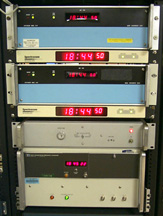 Master Time Facility at the UDel Internet Research Laboratory
Master Time Facility at the UDel Internet Research Laboratory
Last update:
Drivers for most radio and modem reference clocks is included by default in the NTP distribution. Individual drivers can be activated using server commands as described in the ntpd program manual page. Drivers have addresses in the form 127.127.t.u, where t is the driver type and u is a unit number in the range 0-3 to distinguish multiple instances of the same driver. Most drivers require a serial or parallel port or special bus peripheral, but some can work directly from an audio codec or sound card when availble. The particular device is specified by adding a soft link from the name used by the driver to the device name.
All radio clock drivers require that the radio be set for Coordinated Universal Time (UTC) only. Timezone and standard/daylight adjustments are performed by the kernel. There are difference in the various Unix and Windows port interfaces detected at configuration time, so it is important that the NTP daemon and utilities be compiled on the target system or clone.
When a pulse-per-second (PPS) signal is available, the PPS Clock Discipline driver is can be used. It normally works in conjunction with the reference clock that produces the signal, but can work with another driver or remote server. When PPS kernel features are present, the driver can redirect the PPS signal to the kernel.
In general, performance can be improved, especially when more than one driver is supported, to use the prefer peer function described in the Mitigation Rules and the prefer Keyword page. The prefer peer is ordinarily designated the remote peer or local clock driver which provides the best quality time. All other things equal, only the prefer peer is used to discipline the system clock and jitter-producing "clockhopping" between sources is avoided. This is especially valuable when the PPS clock discipline driver is available.
There are audio drivers for each of the NIST time stations WWV and WWVH, Canadian time station CHU and generic IRIG signals. Currently, support for FreeBSD, Solaris and SunOS is in the distribution. It is left to the volunteer corps to confirm this works in other systems. Further information on hookup, debugging and monitoring is given in the Audio Drivers page.
The Undisciplined Local Clock driver can simulate a reference clock when no external synchronization sources are available. If a server with this driver is connected directly or indirectly to the public Internet, there is some danger that it can destabilize other clients. It is not recommended that the loccal clock driver be used in this way, as the orphan mode descibed on the Association Management page provides a generic backup capability.
The local clock driver can also be used when an external synchronization source such as the IEEE 1588 Precision Time Protocol or NIST Lockclock directly synchronizes the computer time. Further information is on the External Clock Discipline and the Local Clock Driver page.
Some drivers depending on longwave or shortwave radio services need to know the radio propagation time from the transmitter to the receiver. This must be calculated for each specific receiver location and requires the geographic coordinates of both the transmitter and receiver. The transmitter coordinates for various radio services are given in the Time and Frequency Standard Station Information page. Receiver coordinates can be obtained locally or from Google Earth. The actual calculations are beyond the scope of this document.
Depending on interface type, port speed, etc., a reference clock can have a small residual offset relative to another. To reduce the effects of jitter when switching from one driver to the another, it is useful to calibrate the drivers to a common ensemble offset. The enable calibrate configuration command described on the Miscellaneous Options page activates a special feature which automatically calculates a correction factor for each driver relative to an association designated the prefer peer.
Following is a list showing the type and title of each driver currently implemented. The compile-time identifier for each is shown in parentheses. Click on a selected type for specific description and configuration documentation, including the clock address, reference ID, driver ID, device name and serial line speed. For those drivers without specific documentation, please contact the author listed in the Copyright Notice page.